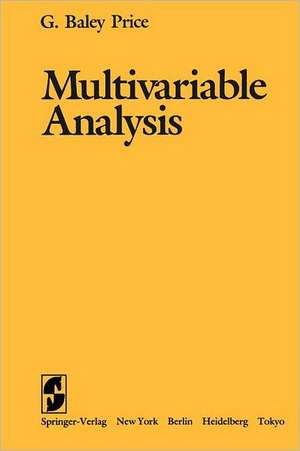Multivariable Analysis
Autor Griffith B. Priceen Limba Engleză Paperback – 26 sep 2011
Preț: 489.36 lei
Preț vechi: 575.72 lei
-15% Nou
Puncte Express: 734
Preț estimativ în valută:
93.64€ • 98.01$ • 77.94£
93.64€ • 98.01$ • 77.94£
Carte tipărită la comandă
Livrare economică 31 martie-14 aprilie
Preluare comenzi: 021 569.72.76
Specificații
ISBN-13: 9781461297475
ISBN-10: 1461297478
Pagini: 672
Ilustrații: XIV, 656 p.
Dimensiuni: 155 x 235 x 35 mm
Greutate: 0.93 kg
Ediția:Softcover reprint of the original 1st ed. 1984
Editura: Springer
Colecția Springer
Locul publicării:New York, NY, United States
ISBN-10: 1461297478
Pagini: 672
Ilustrații: XIV, 656 p.
Dimensiuni: 155 x 235 x 35 mm
Greutate: 0.93 kg
Ediția:Softcover reprint of the original 1st ed. 1984
Editura: Springer
Colecția Springer
Locul publicării:New York, NY, United States
Public țintă
ResearchCuprins
Differentiate Functions and Their Derivatives.- 1. Introduction.- 2. Definitions and Notation.- 3. Elementary Properties of Differentiable Functions.- 4. Derivatives of Composite Functions.- 5. Compositions with Linear Functions.- 6. Classes of Differentiable Functions.- 7. The Derivative as an Operator.- Uniform Differentiability and Approximations; Mappings.- 8. Introduction.- 9. The Mean-Value Theorem: A Generalization.- 10. Uniform Differentiability.- 11. Approximation of Increments of Functions.- 12. Applications: Theorems on Mappings.- Simplexes, Orientations, Boundaries, and Simplicial Subdivisions.- 13. Introduction.- 14. Barycentric Coordinates, Convex Sets, and Simplexes.- 15. Orientation of Simplexes.- 16. Complexes and Chains.- 17. Boundaries of Simplexes and Chains.- 18. Boundaries in a Euclidean Complex.- 19. Affine and Barycentric Transformations.- 20. Three Theorems on Determinants.- 21. Simplicial Subdivisions.- Sperner’s Lemma and the Intermediate-Value Theorem.- 22.Introduction.- 23. Sperner Functions; Sperner’s Lemma.- 24. A Special Class of Sperner Functions.- 25. Properties of the Degree of a Function.- 26. The Degree of a Curve.- 27. The Intermediate-Value Theorem.- 28. Sperner’s Lemma Generalized.- 29. Generalizations to Higher Dimensions.- The Inverse-Function Theorem.- 30. Introduction.- 31. The One-Dimensional Case.- 32. The First Step: A Neighborhood is Covered.- 33. The Inverse-Function Theorem.- Integrals and the Fundamental Theorem of the Integral Calculus.- 34. Introduction.- 35. The Riemann Integral in ?n.- 36. Surface Integrals in ?n.- 37. Integrals on an m-Simplex in ?n.- 38. The Fundamental Theorem of the Integral Calculus.- 39. The Fundamental Theorem of the Integral Calculus for Surfaces.- 40. The Fundamental Theorem on Chains.- 41. Stokes’ Theorem and Related Results.- 42. The Mean-Value Theorem.- 43. An Addition Theorem for Integrals.- 44. Integrals Which Are Independent of the Path.- 45. The Area of a Surface.- 46. Integralsof Uniformly Convergent Sequences of Functions.- Zero Integrals, Equal Integrals, and the Transformation of Integrals.- 47. Introduction.- 48. Some Integrals Which Have the Value Zero.- 49. Integrals Over Surfaces with the Same Boundary.- 50. Integrals on Affine Surfaces with the Same Boundary.- 51. The Change-of-Variable Theorem.- The Evaluation of Integrals.- 52. Introduction.- 53. Definitions.- 54. Functions and Primitives.- 55. Integrals and Evaluations.- 56. The Existence of Primitives: Derivatives of a Single Function.- 57. The Existence of Primitives: The General Case.- 58. Iterated Integrals.- The Kronecker Integral and the Sperner Degree.- 59. Preliminaries.- 60. The Area and the Volume of a Sphere.- 61. The Kronecker Integral.- 62. The Kronecker Integral and the Sperner Degree.- Differentiable Functions of Complex Variables.- 63. Introduction.- I: Functions of a Single Complex Variable.- 64. Differentiable Functions; The Cauchy—Riemann Equations.- 65. The Stolz Condition.- 66. Integrals.- 67. A Special Case of Cauchy’s Integral Theorem.- 68. Cauchy’s Integral Formula.- 69. Taylor Series for a Differentiable Function.- 70. Complex-Valued Functions of Real Variables.- 71. Cauchy’s Integral Theorem.- II: Functions of Several Complex Variables.- 72. Derivatives.- 73. The Cauchy—Riemann Equations and Differentiability.- 74. Cauchy’s Integral Theorem.- Determinants.- 75. Introduction to Determinants.- 76. Definition of the Determinant of a Matrix.- 77. Elementary Properties of Determinants.- 78. Definitions and Notation.- 79. Expansions of Determinants.- 80. The Multiplication Theorems.- 81. Sylvester’s Theorem of 1839 and 1851.- 82. The Sylvester—Franke Theorem.- 83. The Bazin—Reiss—Picquet Theorem.- 84. Inner Products.- 85. Linearly Independent and Dependent Vectors; Rank of a Matrix.- 86. Schwarz’s Inequality.- 87. Hadamard’s Determinant Theorem.- Real Numbers, Euclidean Spaces, and Functions.- 88. Some Properties of the Real Numbers.- 93. The Nested Interval Theorem.- 94. The Bolzano—Weierstrass Theorem.- 95. The Heine—Borel Theorem.- 96. Functions.- 97. Cauchy Sequences.- References and Notes.- Index of Symbols.













